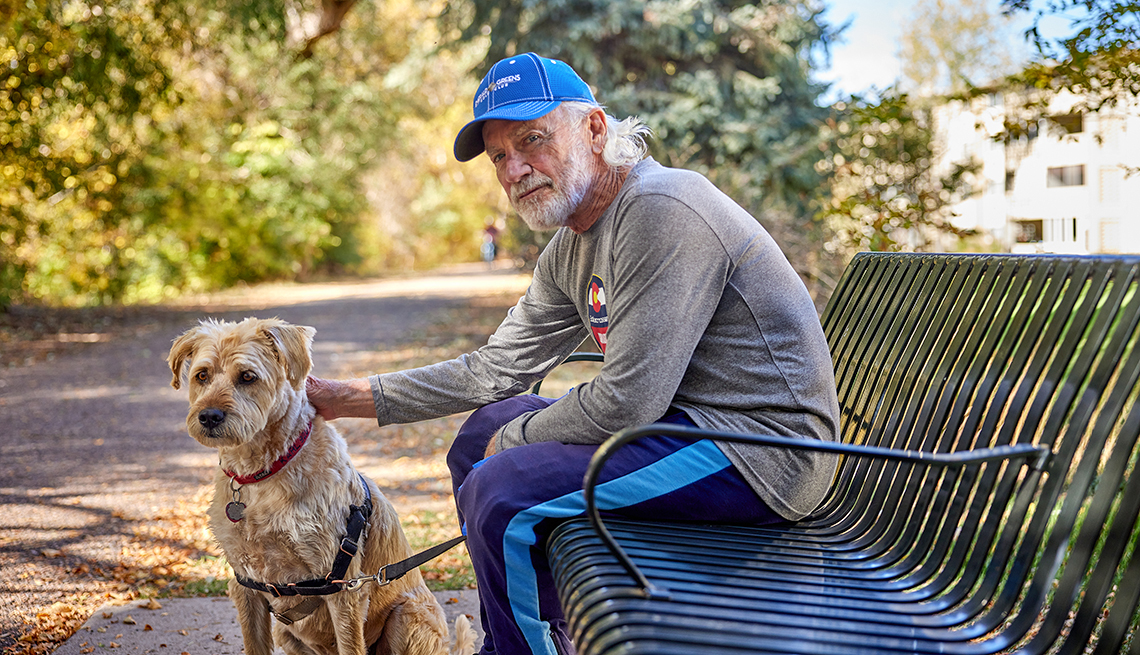AARP Eye Center
AARP Grants Help Transform Public Spaces in Colorado
Four days a week, James Keyworth, 82, runs with his dog along the High Line Canal trail near his Denver home in the 55-plus community of Windsor Gardens.
More than 350,000 people live within a mile of the trail, which is used more than 1 million times annually. The 71-mile corridor meanders through a variety of landscapes, from a canyon and rolling foothills to neighborhoods, parks, a nature preserve and an urban prairie.
“[It] is such a spectacular asset,” Keyworth says.
To help improve trail access for people of all abilities, the nonprofit High Line Canal Conservancy this year received a $2,500 AARP Community Challenge grant to commission walk audits in multiple communities that will provide trail trekkers with updated information about access points and street crossings. It will also identify ways to remove barriers to access.

Getting detailed information about the physical landscape of the trail will help people to make informed decisions about how to best enjoy the canal, says Breana Winters, the conservancy’s associate director of community programs.
The nonprofit is one of seven Colorado organizations that received 2024 AARP Community Challenge grants, totaling nearly $83,000. The grants fund projects aimed at improving public spaces, housing, transit and civic engagement, among other goals. Nationally, AARP awarded $3.8 million in grants for 343 projects this year.
Communities know best what improvements will support residents 50 and over, and the grants help to meet those needs, says Marissa Volpe, AARP Colorado’s associate state director for livable and diverse communities.
Improving transit
Other AARP Community Challenge grant projects this year are also aimed at making it easier for residents to safely navigate their communities.

In the western part of the state, Montrose-based nonprofit All Points Transit is using a $17,547 grant to install shelters and benches at bus stops in the rural area.
In southern Colorado, a nonprofit is using $2,500 in funding to conduct bike audits and develop strategies to enhance safety on frequently used routes in the city of Alamosa.
The audits brought together community members, government officials and other groups to consider road design, says Annie Altwarg, active transportation coordinator for San Luis Valley Great Outdoors.
While some residents use bicycles for recreation, others rely on bikes as their only mode of transportation. Altwarg says it’s important “to build a culture where it feels safe and it’s respected to bicycle as a mode of transportation.”
Several organizations in Denver are also undertaking AARP-funded projects.
The Denver Regional Mobility & Access Council is using a $16,398 grant to educate older residents about transportation options—both public and private—to help them remain independent and travel where they need to go.
The nonprofit Denver Streets Partnership is using a $20,000 grant to bring together residents of the city’s Sun Valley neighborhood to discuss how to reconnect and make more livable an area that historically has been divided by a large roadway interchange.
Empowering residents
Two other grants this year are helping older Coloradans learn new skills.
Fort Collins is using its $20,000 in funds to host do-it-yourself plumbing and power tool workshops that will help residents in three mobile home parks make simple home repairs, improve living conditions and save money.
At Centro San Juan Diego in Denver, a $4,000 grant is helping to support customized computer classes for older Spanish-speaking residents. Skills taught include internet navigation, Word documents, basic Excel and digital backup of important documents and photos.
The classes have been in greater demand since the pandemic, says Lucy Morroni, the center’s operations manager. Affiliated with the Archdiocese of Denver, the center works to remove barriers and meet the needs of immigrants in the city.
“So much of what we do ... relies on technology.... Among the community we serve, there’s a desire to learn basic skills so that these students aren’t reliant on their families necessarily, or asking their kids or grandkids for help,” Morroni says.
The grants are a part of AARP’s national Livable Communities initiative.
Cynthia Pasquale is a freelance writer and former editor at The Denver Post. She has written for the Bulletin since 2011.
More on Livability

































































